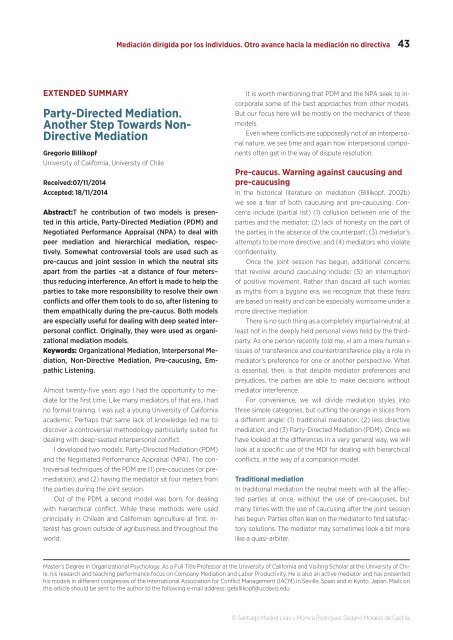Revista-Mediacion-14
Revista-Mediacion-14
Revista-Mediacion-14
Create successful ePaper yourself
Turn your PDF publications into a flip-book with our unique Google optimized e-Paper software.
Mediación dirigida por los individuos. Otro avance hacia la mediación no directiva 43<br />
EXTENDED SUMMARY<br />
Party-Directed Mediation.<br />
Another Step Towards Non-<br />
Directive Mediation<br />
Gregorio Billikopf<br />
University of California, University of Chile<br />
Received:07/11/20<strong>14</strong><br />
Accepted: 18/11/20<strong>14</strong><br />
Abstract:T he contribution of two models is presented<br />
in this article, Party-Directed Mediation (PDM) and<br />
Negotiated Performance Appraisal (NPA) to deal with<br />
peer mediation and hierarchical mediation, respectively.<br />
Somewhat controversial tools are used such as<br />
pre-caucus and joint session in which the neutral sits<br />
apart from the parties –at a distance of four meters–<br />
thus reducing interference. An effort is made to help the<br />
parties to take more responsibility to resolve their own<br />
conflicts and offer them tools to do so, after listening to<br />
them empathically during the pre-caucus. Both models<br />
are especially useful for dealing with deep seated interpersonal<br />
conflict. Originally, they were used as organizational<br />
mediation models.<br />
Keywords: Organizational Mediation, Interpersonal Mediation,<br />
Non-Directive Mediation, Pre-caucusing, Empathic<br />
Listening.<br />
Almost twenty-five years ago I had the opportunity to mediate<br />
for the first time. Like many mediators of that era, I had<br />
no formal training. I was just a young University of California<br />
academic. Perhaps that same lack of knowledge led me to<br />
discover a controversial methodology particularly suited for<br />
dealing with deep-seated interpersonal conflict.<br />
I developed two models, Party-Directed Mediation (PDM)<br />
and the Negotiated Performance Appraisal (NPA). The controversial<br />
techniques of the PDM are (1) pre-caucuses (or premediation);<br />
and (2) having the mediator sit four meters from<br />
the parties during the joint session.<br />
Out of the PDM, a second model was born, for dealing<br />
with hierarchical conflict. While these methods were used<br />
principally in Chilean and Californian agriculture at first, interest<br />
has grown outside of agribusiness and throughout the<br />
world.<br />
It is worth mentioning that PDM and the NPA seek to incorporate<br />
some of the best approaches from other models.<br />
But our focus here will be mostly on the mechanics of these<br />
models.<br />
Even where conflicts are supposedly not of an interpersonal<br />
nature, we see time and again how interpersonal components<br />
often get in the way of dispute resolution.<br />
Pre-caucus. Warning against caucusing and<br />
pre-caucusing<br />
In the historical literature on mediation (Billikopf, 2002b)<br />
we see a fear of both caucusing and pre-caucusing. Concerns<br />
include (partial list) (1) collusion between one of the<br />
parties and the mediator; (2) lack of honesty on the part of<br />
the parties in the absence of the counterpart; (3) mediator’s<br />
attempts to be more directive; and (4) mediators who violate<br />
confidentiality.<br />
Once the joint session has begun, additional concerns<br />
that revolve around caucusing include: (5) an interruption<br />
of positive movement. Rather than discard all such worries<br />
as myths from a bygone era, we recognize that these fears<br />
are based on reality and can be especially worrisome under a<br />
more directive mediation.<br />
There is no such thing as a completely impartial neutral; at<br />
least not in the deeply held personal views held by the thirdparty.<br />
As one person recently told me, «I am a mere human.»<br />
Issues of transference and countertransference play a role in<br />
mediator’s preference for one or another perspective. What<br />
is essential, then, is that despite mediator preferences and<br />
prejudices, the parties are able to make decisions without<br />
mediator interference.<br />
For convenience, we will divide mediation styles into<br />
three simple categories, but cutting the orange in slices from<br />
a different angle: (1) traditional mediation; (2) less directive<br />
mediation; and (3) Party-Directed Mediation (PDM). Once we<br />
have looked at the differences in a very general way, we will<br />
look at a specific use of the MDI for dealing with hierarchical<br />
conflicts, in the way of a companion model.<br />
Traditional mediation<br />
In traditional mediation the neutral meets with all the affected<br />
parties at once, without the use of pre-caucuses, but<br />
many times with the use of caucusing after the joint session<br />
has begun. Parties often lean on the mediator to find satisfactory<br />
solutions. The mediator may sometimes look a bit more<br />
like a quasi-arbiter.<br />
Master’s Degree in Organizational Psychology. As a Full Title Professor at the University of California and Visiting Scholar at the University of Chile,<br />
his research and teaching performance focus on Company Mediation and Labor Productivity. He is also an active mediator and has presented<br />
his models in different congresses of the International Association for Conflict Management (IACM) in Seville, Spain and in Kyoto, Japan. Mails on<br />
this article should be sent to the author to the following e-mail address: gebillikopf@ucdavis.edu<br />
© Santiago Madrid Liras y Mónica Rodríguez-Sedano Morales de Castilla


